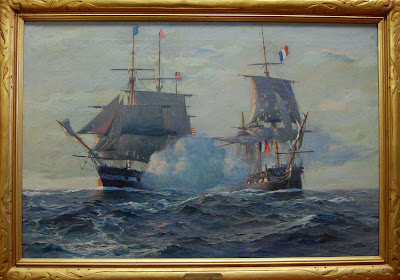Artifact Spotlight: USS Lexington (CV 16) photo album
Captain Thomas H. Robbins must have felt a deep sense of
gratification when he stepped down as commanding officer of USS Lexington (CV 16). Having assumed
command in January 1945, he directed the ship’s operations during the last
months of the war with Japan and witnessed the surrender in Tokyo Bay. When he
was recalled to the United States in November following his promotion to rear
admiral, his crew presented him with a personalized photo album as a going away
gift. Luckily for us, this album recently found its way to the Naval War
College Museum as part of a donation made by the daughter of Rear Admiral Robbins. It contains
a wealth of photographs that document Lexington’s
activities during the final battles of the war in the Pacific as well as peace
time operations in Japan immediately following the surrender. Few, if any, of
these photos have been published, and we are thrilled to have it as one of the
newest additions to our collection.
The Japanese battleship Ise
appears in the upper left corner of this photo. After the loss of four carriers
at Midway in 1942, the Imperial Japanese Navy converted Ise to a hybrid battleship-aircraft carrier to make up for the
losses. Lexington teamed up with
other carriers from Task Force 58 to sink her on July 28, 1945.
Refueling at sea is a difficult procedure even under the
best of conditions. The risk of an accident grows even greater when it has to
be done in stormy weather. Here, USS Ault
(DD 698) conducts underway replenishment with Lexington.
Lexington’s pilots
took this dramatic photograph showing one of their first overflights of Japanese prisoner of war camps in late August 1945. They immediately began round-the-clock flights to
drop food, medicine, clothing, and even a letter from Robbins informing
them that the war was over.
Lexington’s
scoreboard at the end of the war shows the incredible amount of damage she did
to Japan’s air and naval forces.
This donation is especially valuable given Rear Admiral Robbins’
close connection with the Naval War College. He graduated as a student in 1937
and returned in 1953 to serve as chief of staff. Robbins went on to become
acting President before receiving his own appointment to the Presidency in
1956.
Rob Doane
Curator, Naval War College Museum






Comments
Post a Comment